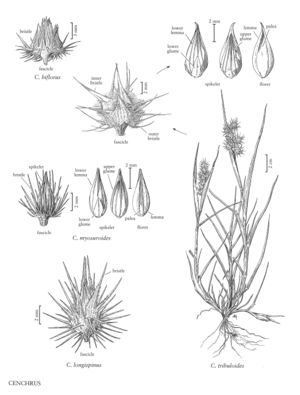Difference between revisions of "Cenchrus tribuloides"
FNA>Volume Importer |
FNA>Volume Importer |
||
| Line 17: | Line 17: | ||
-->{{Treatment/Body | -->{{Treatment/Body | ||
|distribution=Maine;Md.;N.J.;Conn.;N.Y.;Miss.;La.;Pa.;Del.;Ala.;N.C.;S.C.;Va.;Pacific Islands (Hawaii);Vt.;Ga.;Mass.;Fla. | |distribution=Maine;Md.;N.J.;Conn.;N.Y.;Miss.;La.;Pa.;Del.;Ala.;N.C.;S.C.;Va.;Pacific Islands (Hawaii);Vt.;Ga.;Mass.;Fla. | ||
| − | |discussion=<p | + | |discussion=<p>Cenchrus tribuloides grows in moist, sandy dunes and is restricted to the eastern United States. It differs from C. spinifex in its larger spikelets and smaller number of spikelets per fascicle, and from C. longispinus in its densely pubescent fascicles, fewer bristles, and wider inner bristles.</p> |
|tables= | |tables= | ||
|references= | |references= | ||
| Line 33: | Line 33: | ||
|basionyms= | |basionyms= | ||
|family=Poaceae | |family=Poaceae | ||
| + | |illustrator=Linda A. Vorobik and Annaliese Miller | ||
|distribution=Maine;Md.;N.J.;Conn.;N.Y.;Miss.;La.;Pa.;Del.;Ala.;N.C.;S.C.;Va.;Pacific Islands (Hawaii);Vt.;Ga.;Mass.;Fla. | |distribution=Maine;Md.;N.J.;Conn.;N.Y.;Miss.;La.;Pa.;Del.;Ala.;N.C.;S.C.;Va.;Pacific Islands (Hawaii);Vt.;Ga.;Mass.;Fla. | ||
|reference=None | |reference=None | ||
| Line 38: | Line 39: | ||
|publication year= | |publication year= | ||
|special status= | |special status= | ||
| − | |source xml=https:// | + | |source xml=https://bibilujan@bitbucket.org/aafc-mbb/fna-data-curation.git/src/314eb390f968962f596ae85f506b4b3db8683b1b/coarse_grained_fna_xml/V25/V25_1378.xml |
|subfamily=Poaceae subfam. Panicoideae | |subfamily=Poaceae subfam. Panicoideae | ||
|tribe=Poaceae tribe Paniceae | |tribe=Poaceae tribe Paniceae | ||
Revision as of 16:15, 30 October 2019
Plants annual. Culms 10-70 cm, decumbent, branching and rooting at the lower nodes. Sheaths compressed, glabrous or pubescent; ligules 1-2.1 mm; blades 2-14 cm long, 3-14.2 mm wide. Panicles 2-8.2 cm; fascicles 9-16 mm long, 4-8 mm wide, imbricate, ovoid, densely pubescent; bristles 15-43; outer bristles usually present, flattened or terete; inner bristles 4-8 mm long, 1.2-3 mm wide, fused for at least 1/2 their length, forming a distinct cupule, the distal portions diverging at irregular intervals from the cupule, stramineous or purple. Spikelets 1(2) per fascicle, 6-8.8 mm. Lower glumes 1-4 mm; upper glumes 4.9-6.8 mm, 3-7-veined; lower lemmas 5.5-7.5 mm, 3-7-veined, enclosing the palea; upper lemmas 6-8.7 mm; anthers 0.8-2.8 mm. Caryopses 2.6-4 mm long, 2.2-3.1 mm wide, ovoid-elliptic. 2n = 34.
Distribution
Maine, Md., N.J., Conn., N.Y., Miss., La., Pa., Del., Ala., N.C., S.C., Va., Pacific Islands (Hawaii), Vt., Ga., Mass., Fla.
Discussion
Cenchrus tribuloides grows in moist, sandy dunes and is restricted to the eastern United States. It differs from C. spinifex in its larger spikelets and smaller number of spikelets per fascicle, and from C. longispinus in its densely pubescent fascicles, fewer bristles, and wider inner bristles.
Selected References
None.
